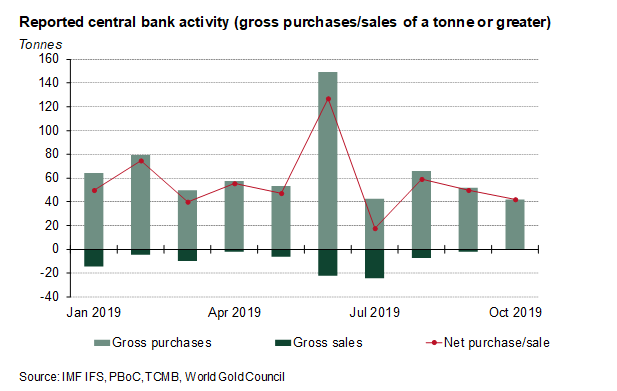Our latest central bank data is now available on Goldhub and makes for interesting reading. Looking at the latest statistics on gold, monthly increases (of a tonne or greater) in gold reserves have begun to ease over the past three months. In October, reported net purchases totalled a healthy 41.8t, but this was 16% lower than September (49.6t), which itself was 16% lower than August (59t).
Central bank demand remains healthy but showing signs of slowing
6 December, 2019
Russia and Turkey were the largest purchases in October, increasing gold reserves by 10.2t and 12.8t respectively. Chinese gold reserves remained flat during the month, however this lost in demand was offset by the reported nine tonne increase in Serbian gold reserves.1 The only other notable purchases during October came from Uzbekistan (6.5t) , United Arab Emirates (2t) and Mongolia (1.3t). On the gross sales side, Germany and Kazakhstan were the only two countries which have – so far – reported a (fractional) decrease in gold reserves in October.
Year-to-date, reported net purchases totalled almost 562t at the end of October. This brought reported global gold reserves to 34,500.8t, 15% higher than the all-time low of 29,963.5t in March 2009 and only 10% shy of the all-time high of 38,491.2t in July 1966. A total of 15 banks have now increased global gold reserves by a tonne or more, with only three showing decreases.
Given the level of purchasing so far this year – monthly reported net purchases have averaged 56t – it’ll be interesting to see what the final two months of the year bring.
Don’t forget, if you want to interrogate the data further, our detailed central bank data set can be found here.
1This has yet to be reported via the IMF, but details are provided by Bloomberg: www.bloomberg.com/news/articles/2019-11-14/serbia-buys-nine-tons-of-gold-to-heed-president-s-crisis-advice

